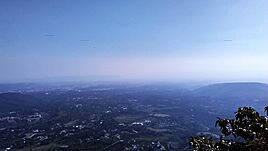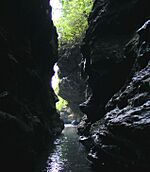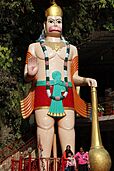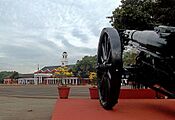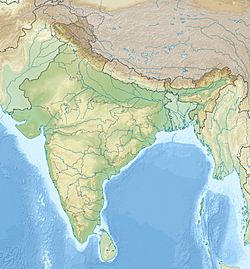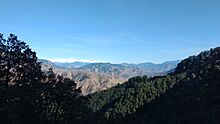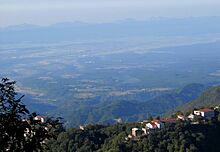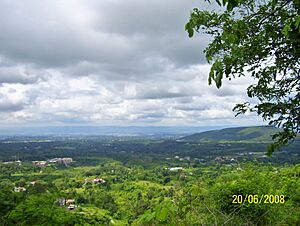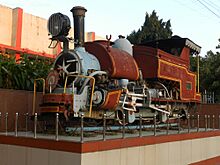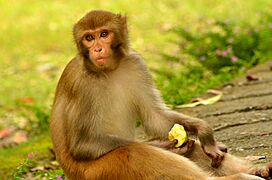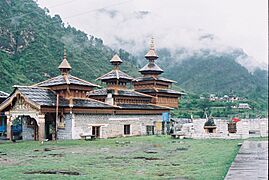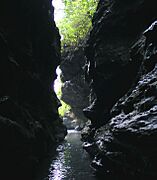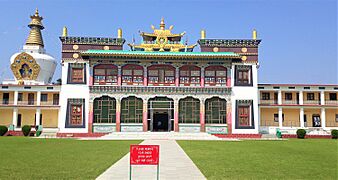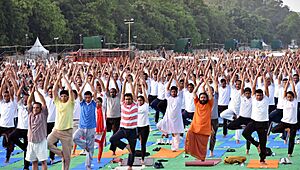Dehradun facts for kids
Quick facts for kids
Dehradun
Dēharādūna
Dehra Doon
|
|
|---|---|
|
Metropolis
|
|
|
Doon Valley
Robber's Caves
Tapkeshwar Temple
Indian Military Academy
Khalanga War Memorial
Dehradun stadium
Forest Research Institute
|
|
| Nickname(s):
Doon
|
|
| Country | |
| State | |
| District | Dehradun |
| Founded | 1817 |
| Municipality | 1867 |
| Government | |
| • Type | Mayor–Council |
| • Body | Dehradun Municipal Corporation |
| Area | |
| • Metropolis | 196.48 km2 (75.86 sq mi) |
| • Metro | 300 km2 (100 sq mi) |
| Elevation | 450 m (1,480 ft) |
| Population | |
| • Metropolis | 803,983 (2,018) |
| • Rank | 79th |
| • Metro | 1,279,083 (2,021) |
| Languages | |
| • Official | Hindi |
| • Additional official | Sanskrit |
| • Regional | Garhwali, Jaunsari |
| Time zone | UTC+5:30 (IST) |
| PIN |
248001
|
| Telephone code | +91-135 |
| Vehicle registration | UK-07 |
| HDI (2016) | |
Dehradun (also known as Dehra Doon) is a big city in Uttarakhand, India. It is the winter capital and the most populated city in the state. Dehradun is the main city of the Dehradun district. The state government even holds its winter meetings here. It is also a "Counter Magnet" city for the National Capital Region (NCR). This means it helps spread growth away from the crowded city of Delhi.
Dehradun is in the beautiful Doon Valley. It sits at the bottom of the Himalayas, between the Song River and the Asan River. The city is famous for its lovely scenery and is a starting point for exploring the nearby mountains.
This city is a major place for learning and research. It has many important schools and institutes. These include the Indian Military Academy and the Forest Research Institute. Dehradun is also known for its special Basmati rice and tasty bakery items. It is considered one of India's safest cities.
Dehradun is sometimes called the "Abode of Drona." This name comes from an ancient teacher, Dronacharya. The city has been important for different rulers throughout history. It was first taken by the Gorkha Kings and then by the British. Because of its important military schools, the Indian Armed Forces have a strong presence here.
The city is well-connected to many amazing Himalayan tourist spots. These include Mussoorie, Dhanaulti, and Chakrata. It is also a gateway to holy Hindu cities like Haridwar and Rishikesh.
Contents
What's in a Name?
The name Dehradun comes from two words: "dehra" and "dun." "Dehra" means temple or home. "Dun" means a valley at the foot of hills.
The city started when Baba Ram Rai built a temple (gurudwara) here in the 1600s. Baba Ram Rai was the son of a Sikh Guru. He was given land in the Garhwal region by the Mughal emperor Aurangzeb. People started calling the area "Dehra Dun" after his camp or shrine. Later, it became Dehradun.
Ancient Hindu stories also connect Dehradun to the name "Dronanagari." This means "city of Drona." It is believed that Dronacharya, a great teacher from the Mahabharata epic, lived here.
A Look Back in Time
Dehradun's history is linked to ancient Indian stories like the Ramayana and Mahabharata. People believe that Rama and Lakshmana visited this area. Also, Dronacharya, the famous teacher from the Mahabharata, is thought to have lived here. Old temples and idols found nearby suggest these connections.
In the 7th century, a Chinese traveler named Huen Tsang wrote about this area. He called it Sudhanagara, which is now known as Kalsi. Important stone messages from Emperor Ashoka have been found near the Yamuna River in Kalsi. This shows the region was important long ago.
A Sikh guru named Baba Ram Rai was given three villages in Dehradun by a Garhwal king. This is how the name "Dehra Dun" came about. It means "Baba Ram Rai's camp in the valley." The main temple, Guru Ram Rai Darbar Sahib, was finished in 1707. Its walls have beautiful paintings that mix different art styles.
Dehradun was attacked by different rulers over time. In 1804, the Gorkha king Amar Singh Thapa took control of the area. But then, the British East India Company fought the Gorkhas in the Anglo-Nepalese War (1814-1816). The war ended with a treaty, and the British gained Dehradun in 1816. They also developed nearby hill stations like Mussoorie.

After India became independent in 1947, Dehradun became part of Uttar Pradesh. In 2000, the new state of Uttarakhand was formed, and Dehradun became its temporary capital.
Afghan Connection
Dehradun has an interesting link to Afghanistan. After the First Anglo-Afghan War, the Afghan leader Dost Mohammad Khan was sent to live in Dehradun by the British. He stayed for over six years. The famous Dehradun Basmati rice is believed to have been brought by him from Afghanistan.
Later, his grandson, Mohammad Yaqub Khan, also came to live in Dehradun. He was the first Afghan to officially settle here. The Kabul Palace, where he lived, is now a college. Even the last king of Afghanistan, Mohammed Nadir Shah, was born in Dehradun. Today, descendants of these Afghan royal families live in Dehradun. The city is even a "home" ground for the Afghan cricket team.
Where is Dehradun?
Dehradun is mostly located in the Doon Valley. Its height above sea level changes, but the average is about 450 meters (1,476 feet). The city is surrounded by hills. The Himalayas are to the north, and the Shivalik Hills are to the south. The Ganges River is to the east, and the Yamuna River is to the west.
The district is home to Rajaji National Park. This park has elephants and other wildlife. You can also find the Benog Wildlife Sanctuary and the Asan Conservation Reserve here. The Doon Valley has different types of forests, including those in the Shivalik hills.
Old Canals
Dehradun used to have many canals that helped water the farms and kept the air cooler. The oldest canal, Rajpur canal, was built in the 1600s. After Dehradun became the capital in 2000, many of these old canals were covered or removed to make roads wider. Some groups are now working to bring them back. They believe the canals are good for the city's environment and beauty.
Weather in Dehradun
Dehradun has a humid subtropical climate. This means it has hot summers and cool winters. In summer, temperatures can reach up to 40°C (104°F). In winter, temperatures are usually between 6°C and 20°C (43°F and 68°F). It can sometimes drop below freezing, but this is not common.
The city gets a lot of rain, especially from June to September. July and August are the wettest months. This heavy rain helps the farms, as the soil is very fertile.
People of Dehradun
In 2011, Dehradun city had a population of about 578,420 people. Most people living in Dehradun are from Uttarakhand. For every 1000 boys, there were about 906 girls.
Hindi is the main language spoken in Dehradun. English is also used a lot, especially by people working in offices. Other local languages include Garhwali and Jaunsari.
Most people in Dehradun follow Hinduism. Islam is the second largest religion. There are also many followers of Sikhism, Christianity, Jainism, and Buddhism.
Dehradun has a very high literacy rate, which means most people can read and write. About 89% of people in the city are literate.
City Services
Dehradun gets its drinking water from springs and underground sources. The Uttarakhand Jal Sansthan (UJS) manages the city's water supply and sewage system. However, only about 30% of the city is covered by the sewage system.
The city produces about 350,000 kg (771,618 lbs) of waste every day. There is a large waste processing plant outside the city. But waste sorting at home is still not very common.
Electricity in Dehradun is provided by the Uttarakhand Power Corporation Limited (UPCL). Many companies offer phone and internet services, like BSNL, Vodafone, and Airtel.
Learning and Research
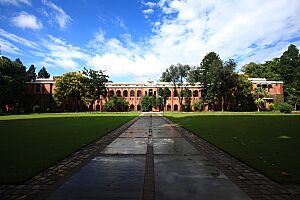
Dehradun is famous for its many schools. These schools follow different education boards like CBSE and ICSE. The language of teaching is usually English or Hindi.
Some well-known schools in Dehradun include The Doon School, Welham Boys School, and Welham Girls School. Many famous people have studied at these schools. There are also many government schools and Kendriya Vidyalayas (central government schools) in the city.
After school, students can go to many colleges and universities in Dehradun. The city has become a major center for higher education. Important research institutes here include the Forest Research Institute (FRI) and the Indian Institute of Remote Sensing.
The FRI trains officers for the Indian Forest Service. The Wildlife Institute of India (WII) does research on wildlife. Dehradun also has four medical colleges. The National Institute for Empowerment of People with Visual Disabilities (NIEPVD) helps blind people. It was the first institute in India to print books in Braille.
City's Economy

Tourism is a big part of Dehradun's economy. The city's economy also gets a boost from its nearby national parks, mountains, and historical sites. Dehradun has seen strong economic growth recently. It has also become a hub for information technology, with special tech parks.
Farming is a major job in Dehradun. The city is famous for its delicious lychees and the world's best basmati rice.
Dehradun is home to many important national training and research institutions. These include the Indian Military Academy and the Oil and Natural Gas Corporation (ONGC). There are also defense factories here that make products for the Indian Armed Forces.
Getting Around
By Air
Dehradun has its own airport called Jolly Grant Airport. It is about 27 km (17 miles) from the city center. This airport is quite busy and is planned to become an international airport. The nearest international airport is in New Delhi. There is also a helicopter service from Dehradun to some towns in the mountains.
By Train
Dehradun railway station is the city's main train station. It was built by the British in 1899. It is the last station on the Northern Railway line in this area. There are plans to make it a world-class travel hub.
By Road
Dehradun is connected to other states like Punjab, Haryana, and Uttar Pradesh by national highways. The city has a good network of roads. The Uttarakhand Transport Corporation runs buses within the city and to other cities. You can also find auto rickshaws and cycle rickshaws for local travel.
Culture and Fun
As the capital city, Dehradun has grown a lot in education, transport, and communication. The city center is easy to spot because of the Clock tower (Ghanta Ghar), which has four working clocks. Many artists and writers, like Ruskin Bond, have lived in Dehradun.
The city hosts many fairs throughout the year. Two important ones are Magh Mela (in January) and Jhanda Mela (in March), which is a big fair for the Sikh community.
Places to Visit
Dehradun has many interesting places to visit. These include the Dehradun Zoo, Robber's Cave, and the Forest Research Institute. You can also visit temples like Tapkeshwar Temple and Santala Devi Temple. The Mindrolling Monastery is a beautiful Buddhist temple.
The tourist spots can be grouped into nature, sports, wildlife, museums, and institutions. Nearby hill stations like Mussoorie are great for nature lovers. Temples offer a spiritual experience. Wildlife sanctuaries are perfect for animal and bird watchers.
Kipling Trail
The Kipling Trail is an old walking path between Dehradun and Mussoorie. It's named after the writer Rudyard Kipling, who is thought to have walked it in the 1880s. It's becoming popular again for hiking and enjoying nature.
Khalanga War Memorial
This memorial remembers the Battle of Nalapani, which was the first battle of the Anglo-Nepalese War in 1814. It was fought near Dehradun.
Robber's Cave
Robber's Cave is a natural cave about 8 km (5 miles) from Dehradun city. It's believed to have been a hideout for a famous bandit named Sultana Daaku. Rivers flow inside the cave, making it a unique and fun place to visit.
Lachhiwala Nature Park
This is a popular spot for picnics, especially in summer. It's known for its forests, man-made water pools, and great opportunities for bird watching.
Tapkeshwar Temple
This temple is dedicated to Lord Shiva. It's located in a natural cave by the Asan river. Water drips onto the main idol inside the cave, which looks amazing. It's believed that Guru Drona lived in this cave.
Dehradun Zoo
This zoo, formerly called Malsi Deer Park, helps protect wild animals. It's also a place for education and rescuing animals. It's located on the Mussoorie Road.
Forest Research Institute
Forest Research Institute (FRI) is a very old and big institute for forest research in India. It was started in 1878. The institute is known for its research and its beautiful British-era buildings.
Uttara Museum of Contemporary Art
This art museum in Dehradun opened in 2017. It's the first art museum in Uttarakhand. It shows artworks about the Kedarnath disaster and the local culture of Uttarakhand.
Regional Science Centre
The Regional Science Centre (RSC) is a great place for school trips. It has a science museum, a planetarium, a 3D theater, and interactive exhibits that explain scientific laws.
Virasat Festival
Virasat is a cultural festival that celebrates India's rich heritage. It started in Dehradun in 1995 and is one of the biggest folk life and heritage festivals in Asia. It includes performances, workshops, and displays of Indian arts, crafts, and traditions.
News and Media
Most of Uttarakhand's media companies are based in Dehradun. Many Hindi newspapers are published here, like Dainik Jagran and Hindustan. There are also English newspapers like The Dehradun Street and The Garhwal Post.
All India Radio has AM and FM radio stations in the city. There are also several private FM radio stations. Doordarshan (India's public TV broadcaster) has a channel for Uttarakhand. You can also watch many other TV channels through cable or satellite.
Sports in Dehradun
The mountains and rivers around Uttarakhand are great for adventure sports. People enjoy paragliding, sky diving, rafting, and bungee jumping here. Dehradun also has India's first indoor ice rink. This rink is big enough for ice hockey and figure skating.
Like in the rest of India, cricket is very popular. The Cricket Association of Uttarakhand is based in Dehradun. The city has the Rajiv Gandhi International Cricket Stadium, which can hold 25,000 people. It is the first international-level stadium in the state. It is the home ground for the Uttarakhand cricket team and a second home for the Afghanistan cricket team.
Buildings and Style
After Dehradun became the capital of Uttarakhand, many new buildings were built. Modern styles have slowly replaced older buildings from the British colonial time. Still, some important old buildings remain. These include the Clock Tower, Forest Research Institute, and the Indian Military Academy.
Famous People from Dehradun
- Abhinav Bindra – Olympic gold medalist shooter
- Anshul Jubli – MMA fighter
- Jubin Nautiyal – Indian singer
- Raghav Juyal – dancer, television host
- Amardeep Jha – film actress
- Ali Abbas Zafar – film director
- Saira Banu – former film actress
- Bobby Cash – country music artist
- Archana Puran Singh – TV, film actress
- Vir Das – film actor and stand-up comedian
- Anirudh Thapa – football player
- Asha Negi – television actress
- Deepak Dobriyal – TV actor
- Himani Shivpuri – Actress
- Ruskin Bond - author
- Shivangi Joshi – TV actor
- Tom Alter – former TV and film actor
See also
 In Spanish: Dehradun para niños
In Spanish: Dehradun para niños


